Legal Aspects of US Healthcare System: A Hospital Administrator's View
VerifiedAdded on 2022/08/23
|7
|1601
|21
Report
AI Summary
This report examines the legal aspects of the US healthcare system, focusing on the responsibilities of nursing professionals and hospital administrators in ensuring patient safety and adherence to medical standards. It discusses the significance of the Surgical Care Improvement Project (SCIP), the importance of adhering to professional codes of conduct, and the implications of Clinical Practice Guidelines. The report also addresses the concept of "failure-to-rescue," the elements required to prove medical malpractice, and the role of hospital governing boards in overseeing quality and safety. It concludes by emphasizing the need for healthcare reform to improve patient outcomes and ensure compliance with legal and ethical standards.
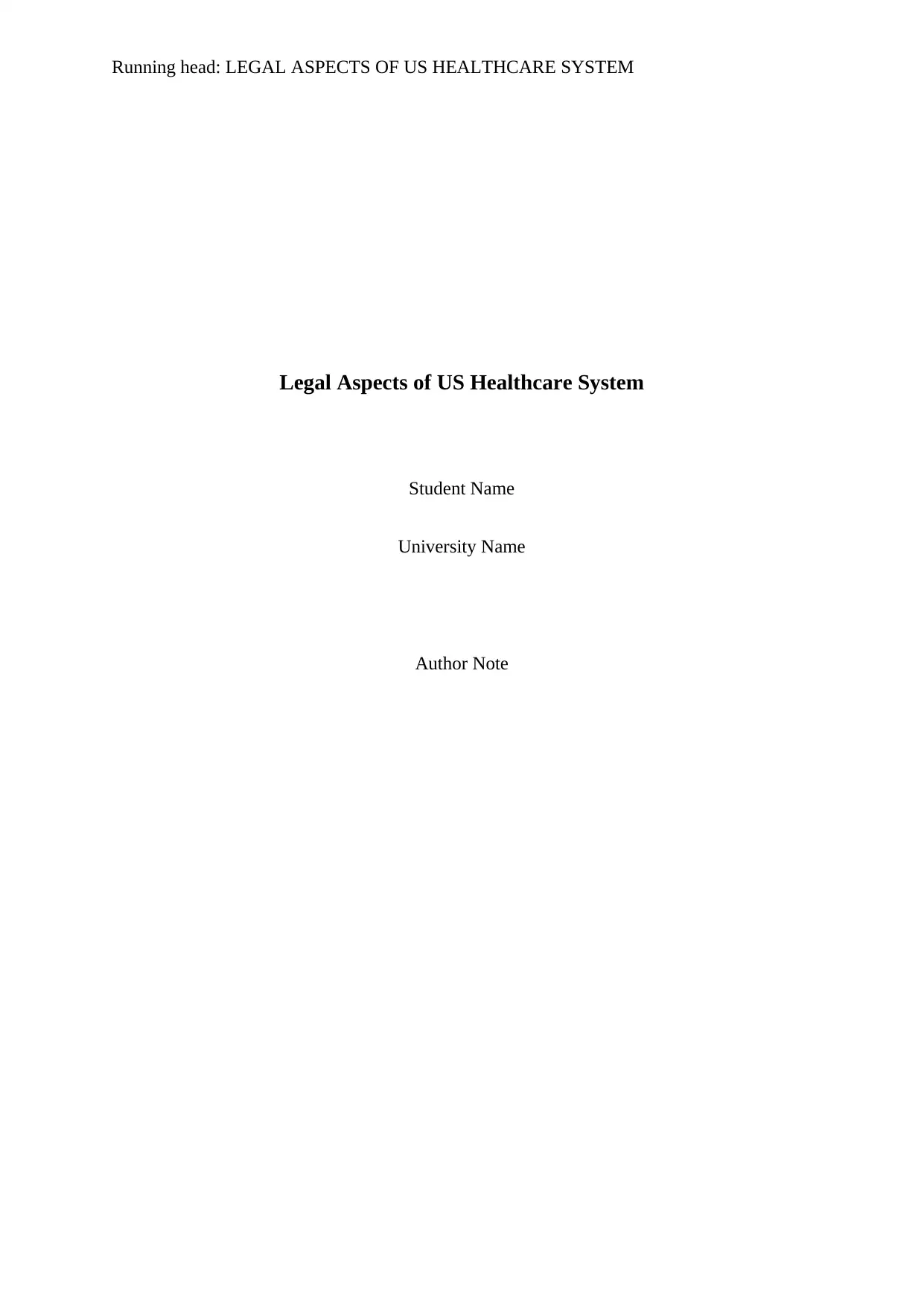
Running head: LEGAL ASPECTS OF US HEALTHCARE SYSTEM
Legal Aspects of US Healthcare System
Student Name
University Name
Author Note
Legal Aspects of US Healthcare System
Student Name
University Name
Author Note
Paraphrase This Document
Need a fresh take? Get an instant paraphrase of this document with our AI Paraphraser
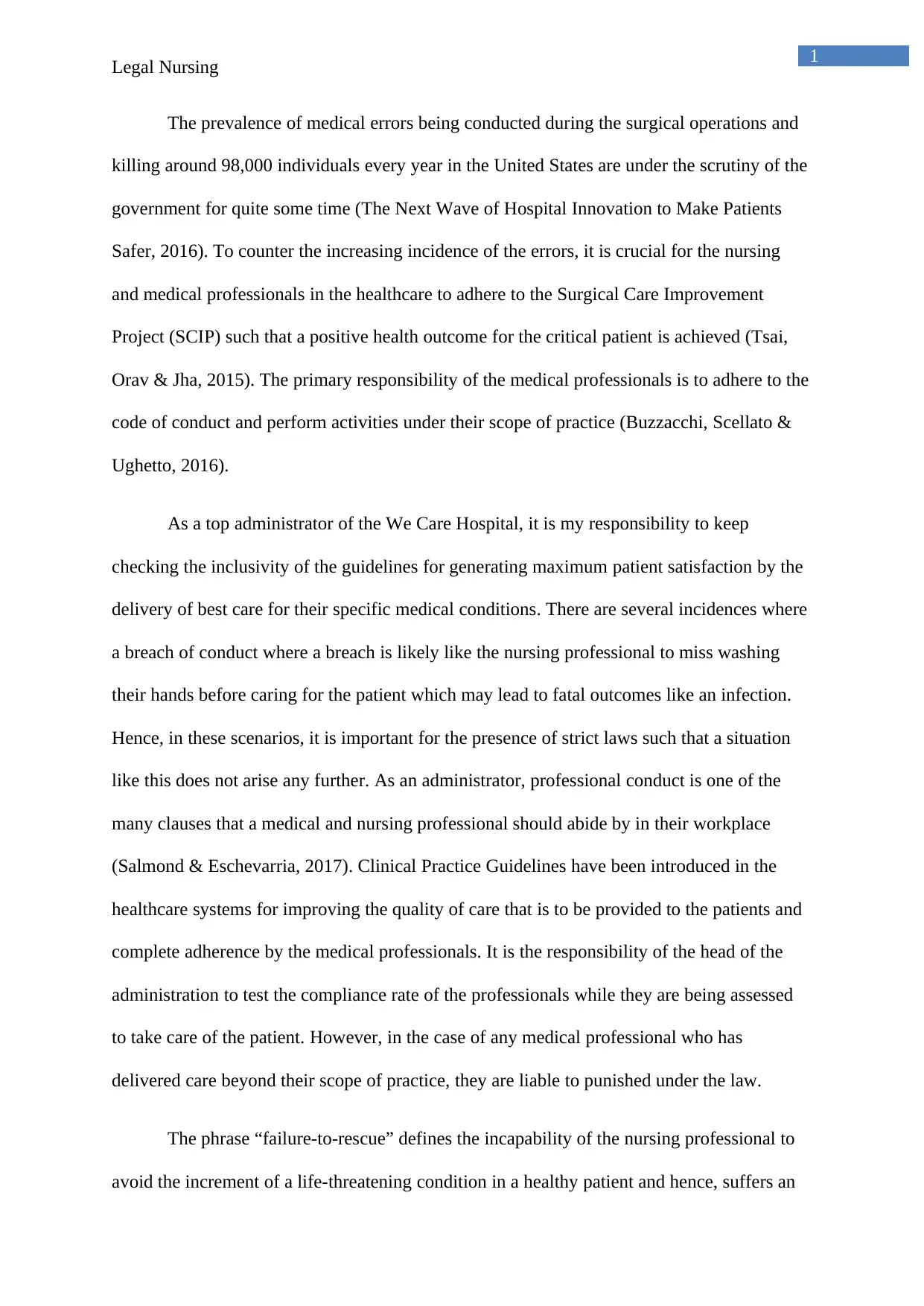
1
Legal Nursing
The prevalence of medical errors being conducted during the surgical operations and
killing around 98,000 individuals every year in the United States are under the scrutiny of the
government for quite some time (The Next Wave of Hospital Innovation to Make Patients
Safer, 2016). To counter the increasing incidence of the errors, it is crucial for the nursing
and medical professionals in the healthcare to adhere to the Surgical Care Improvement
Project (SCIP) such that a positive health outcome for the critical patient is achieved (Tsai,
Orav & Jha, 2015). The primary responsibility of the medical professionals is to adhere to the
code of conduct and perform activities under their scope of practice (Buzzacchi, Scellato &
Ughetto, 2016).
As a top administrator of the We Care Hospital, it is my responsibility to keep
checking the inclusivity of the guidelines for generating maximum patient satisfaction by the
delivery of best care for their specific medical conditions. There are several incidences where
a breach of conduct where a breach is likely like the nursing professional to miss washing
their hands before caring for the patient which may lead to fatal outcomes like an infection.
Hence, in these scenarios, it is important for the presence of strict laws such that a situation
like this does not arise any further. As an administrator, professional conduct is one of the
many clauses that a medical and nursing professional should abide by in their workplace
(Salmond & Eschevarria, 2017). Clinical Practice Guidelines have been introduced in the
healthcare systems for improving the quality of care that is to be provided to the patients and
complete adherence by the medical professionals. It is the responsibility of the head of the
administration to test the compliance rate of the professionals while they are being assessed
to take care of the patient. However, in the case of any medical professional who has
delivered care beyond their scope of practice, they are liable to punished under the law.
The phrase “failure-to-rescue” defines the incapability of the nursing professional to
avoid the increment of a life-threatening condition in a healthy patient and hence, suffers an
Legal Nursing
The prevalence of medical errors being conducted during the surgical operations and
killing around 98,000 individuals every year in the United States are under the scrutiny of the
government for quite some time (The Next Wave of Hospital Innovation to Make Patients
Safer, 2016). To counter the increasing incidence of the errors, it is crucial for the nursing
and medical professionals in the healthcare to adhere to the Surgical Care Improvement
Project (SCIP) such that a positive health outcome for the critical patient is achieved (Tsai,
Orav & Jha, 2015). The primary responsibility of the medical professionals is to adhere to the
code of conduct and perform activities under their scope of practice (Buzzacchi, Scellato &
Ughetto, 2016).
As a top administrator of the We Care Hospital, it is my responsibility to keep
checking the inclusivity of the guidelines for generating maximum patient satisfaction by the
delivery of best care for their specific medical conditions. There are several incidences where
a breach of conduct where a breach is likely like the nursing professional to miss washing
their hands before caring for the patient which may lead to fatal outcomes like an infection.
Hence, in these scenarios, it is important for the presence of strict laws such that a situation
like this does not arise any further. As an administrator, professional conduct is one of the
many clauses that a medical and nursing professional should abide by in their workplace
(Salmond & Eschevarria, 2017). Clinical Practice Guidelines have been introduced in the
healthcare systems for improving the quality of care that is to be provided to the patients and
complete adherence by the medical professionals. It is the responsibility of the head of the
administration to test the compliance rate of the professionals while they are being assessed
to take care of the patient. However, in the case of any medical professional who has
delivered care beyond their scope of practice, they are liable to punished under the law.
The phrase “failure-to-rescue” defines the incapability of the nursing professional to
avoid the increment of a life-threatening condition in a healthy patient and hence, suffers an
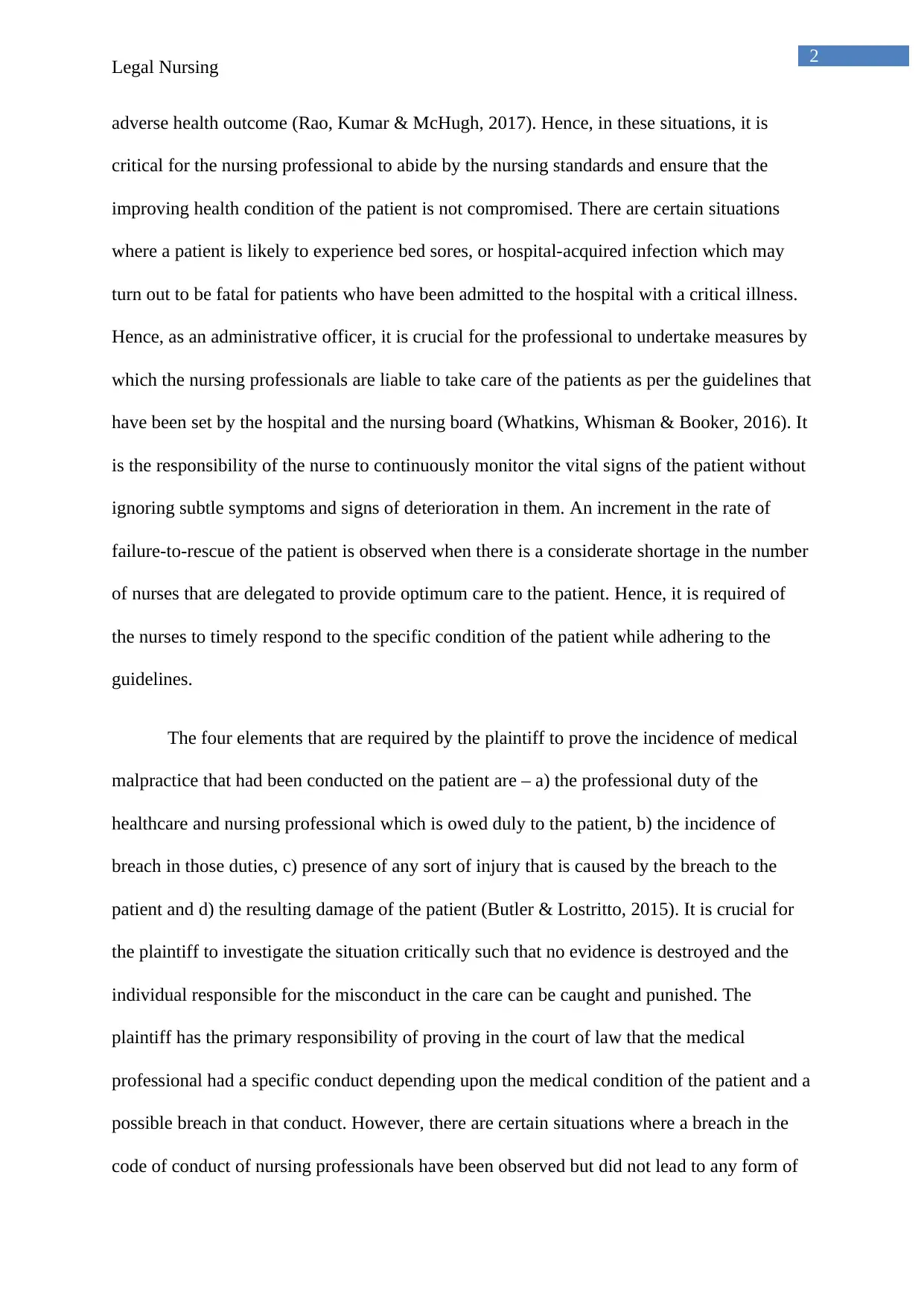
2
Legal Nursing
adverse health outcome (Rao, Kumar & McHugh, 2017). Hence, in these situations, it is
critical for the nursing professional to abide by the nursing standards and ensure that the
improving health condition of the patient is not compromised. There are certain situations
where a patient is likely to experience bed sores, or hospital-acquired infection which may
turn out to be fatal for patients who have been admitted to the hospital with a critical illness.
Hence, as an administrative officer, it is crucial for the professional to undertake measures by
which the nursing professionals are liable to take care of the patients as per the guidelines that
have been set by the hospital and the nursing board (Whatkins, Whisman & Booker, 2016). It
is the responsibility of the nurse to continuously monitor the vital signs of the patient without
ignoring subtle symptoms and signs of deterioration in them. An increment in the rate of
failure-to-rescue of the patient is observed when there is a considerate shortage in the number
of nurses that are delegated to provide optimum care to the patient. Hence, it is required of
the nurses to timely respond to the specific condition of the patient while adhering to the
guidelines.
The four elements that are required by the plaintiff to prove the incidence of medical
malpractice that had been conducted on the patient are – a) the professional duty of the
healthcare and nursing professional which is owed duly to the patient, b) the incidence of
breach in those duties, c) presence of any sort of injury that is caused by the breach to the
patient and d) the resulting damage of the patient (Butler & Lostritto, 2015). It is crucial for
the plaintiff to investigate the situation critically such that no evidence is destroyed and the
individual responsible for the misconduct in the care can be caught and punished. The
plaintiff has the primary responsibility of proving in the court of law that the medical
professional had a specific conduct depending upon the medical condition of the patient and a
possible breach in that conduct. However, there are certain situations where a breach in the
code of conduct of nursing professionals have been observed but did not lead to any form of
Legal Nursing
adverse health outcome (Rao, Kumar & McHugh, 2017). Hence, in these situations, it is
critical for the nursing professional to abide by the nursing standards and ensure that the
improving health condition of the patient is not compromised. There are certain situations
where a patient is likely to experience bed sores, or hospital-acquired infection which may
turn out to be fatal for patients who have been admitted to the hospital with a critical illness.
Hence, as an administrative officer, it is crucial for the professional to undertake measures by
which the nursing professionals are liable to take care of the patients as per the guidelines that
have been set by the hospital and the nursing board (Whatkins, Whisman & Booker, 2016). It
is the responsibility of the nurse to continuously monitor the vital signs of the patient without
ignoring subtle symptoms and signs of deterioration in them. An increment in the rate of
failure-to-rescue of the patient is observed when there is a considerate shortage in the number
of nurses that are delegated to provide optimum care to the patient. Hence, it is required of
the nurses to timely respond to the specific condition of the patient while adhering to the
guidelines.
The four elements that are required by the plaintiff to prove the incidence of medical
malpractice that had been conducted on the patient are – a) the professional duty of the
healthcare and nursing professional which is owed duly to the patient, b) the incidence of
breach in those duties, c) presence of any sort of injury that is caused by the breach to the
patient and d) the resulting damage of the patient (Butler & Lostritto, 2015). It is crucial for
the plaintiff to investigate the situation critically such that no evidence is destroyed and the
individual responsible for the misconduct in the care can be caught and punished. The
plaintiff has the primary responsibility of proving in the court of law that the medical
professional had a specific conduct depending upon the medical condition of the patient and a
possible breach in that conduct. However, there are certain situations where a breach in the
code of conduct of nursing professionals have been observed but did not lead to any form of
⊘ This is a preview!⊘
Do you want full access?
Subscribe today to unlock all pages.

Trusted by 1+ million students worldwide
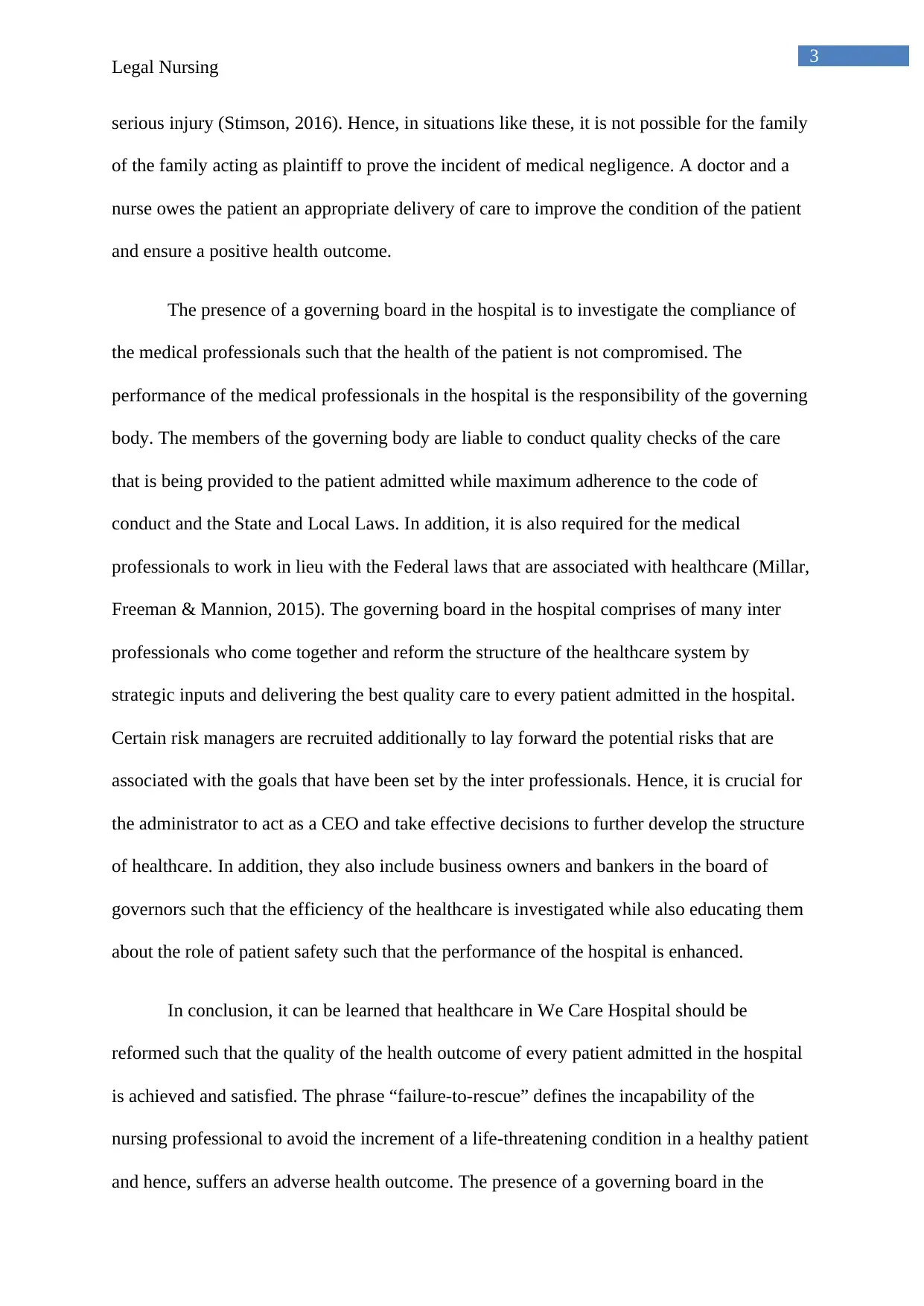
3
Legal Nursing
serious injury (Stimson, 2016). Hence, in situations like these, it is not possible for the family
of the family acting as plaintiff to prove the incident of medical negligence. A doctor and a
nurse owes the patient an appropriate delivery of care to improve the condition of the patient
and ensure a positive health outcome.
The presence of a governing board in the hospital is to investigate the compliance of
the medical professionals such that the health of the patient is not compromised. The
performance of the medical professionals in the hospital is the responsibility of the governing
body. The members of the governing body are liable to conduct quality checks of the care
that is being provided to the patient admitted while maximum adherence to the code of
conduct and the State and Local Laws. In addition, it is also required for the medical
professionals to work in lieu with the Federal laws that are associated with healthcare (Millar,
Freeman & Mannion, 2015). The governing board in the hospital comprises of many inter
professionals who come together and reform the structure of the healthcare system by
strategic inputs and delivering the best quality care to every patient admitted in the hospital.
Certain risk managers are recruited additionally to lay forward the potential risks that are
associated with the goals that have been set by the inter professionals. Hence, it is crucial for
the administrator to act as a CEO and take effective decisions to further develop the structure
of healthcare. In addition, they also include business owners and bankers in the board of
governors such that the efficiency of the healthcare is investigated while also educating them
about the role of patient safety such that the performance of the hospital is enhanced.
In conclusion, it can be learned that healthcare in We Care Hospital should be
reformed such that the quality of the health outcome of every patient admitted in the hospital
is achieved and satisfied. The phrase “failure-to-rescue” defines the incapability of the
nursing professional to avoid the increment of a life-threatening condition in a healthy patient
and hence, suffers an adverse health outcome. The presence of a governing board in the
Legal Nursing
serious injury (Stimson, 2016). Hence, in situations like these, it is not possible for the family
of the family acting as plaintiff to prove the incident of medical negligence. A doctor and a
nurse owes the patient an appropriate delivery of care to improve the condition of the patient
and ensure a positive health outcome.
The presence of a governing board in the hospital is to investigate the compliance of
the medical professionals such that the health of the patient is not compromised. The
performance of the medical professionals in the hospital is the responsibility of the governing
body. The members of the governing body are liable to conduct quality checks of the care
that is being provided to the patient admitted while maximum adherence to the code of
conduct and the State and Local Laws. In addition, it is also required for the medical
professionals to work in lieu with the Federal laws that are associated with healthcare (Millar,
Freeman & Mannion, 2015). The governing board in the hospital comprises of many inter
professionals who come together and reform the structure of the healthcare system by
strategic inputs and delivering the best quality care to every patient admitted in the hospital.
Certain risk managers are recruited additionally to lay forward the potential risks that are
associated with the goals that have been set by the inter professionals. Hence, it is crucial for
the administrator to act as a CEO and take effective decisions to further develop the structure
of healthcare. In addition, they also include business owners and bankers in the board of
governors such that the efficiency of the healthcare is investigated while also educating them
about the role of patient safety such that the performance of the hospital is enhanced.
In conclusion, it can be learned that healthcare in We Care Hospital should be
reformed such that the quality of the health outcome of every patient admitted in the hospital
is achieved and satisfied. The phrase “failure-to-rescue” defines the incapability of the
nursing professional to avoid the increment of a life-threatening condition in a healthy patient
and hence, suffers an adverse health outcome. The presence of a governing board in the
Paraphrase This Document
Need a fresh take? Get an instant paraphrase of this document with our AI Paraphraser
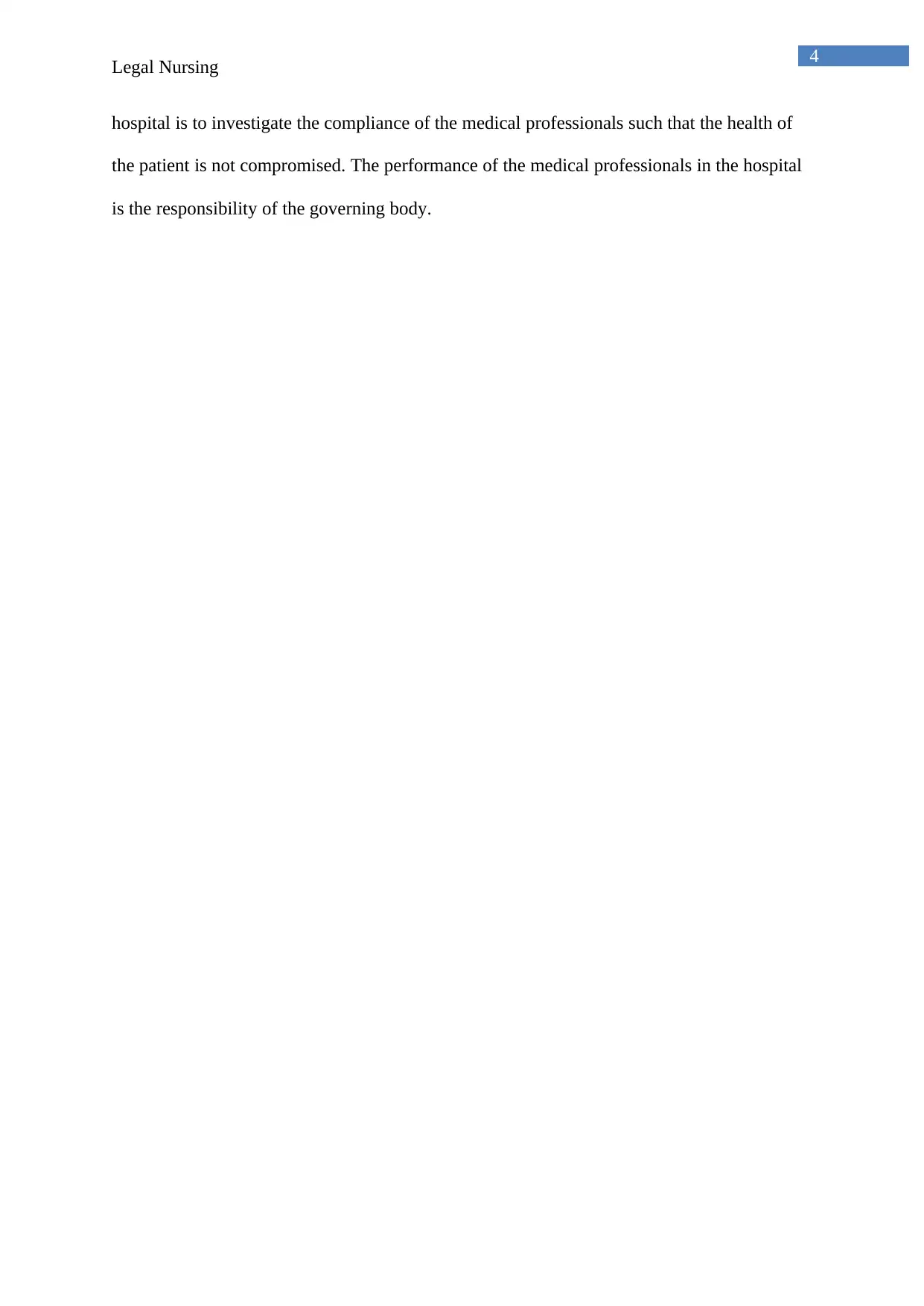
4
Legal Nursing
hospital is to investigate the compliance of the medical professionals such that the health of
the patient is not compromised. The performance of the medical professionals in the hospital
is the responsibility of the governing body.
Legal Nursing
hospital is to investigate the compliance of the medical professionals such that the health of
the patient is not compromised. The performance of the medical professionals in the hospital
is the responsibility of the governing body.
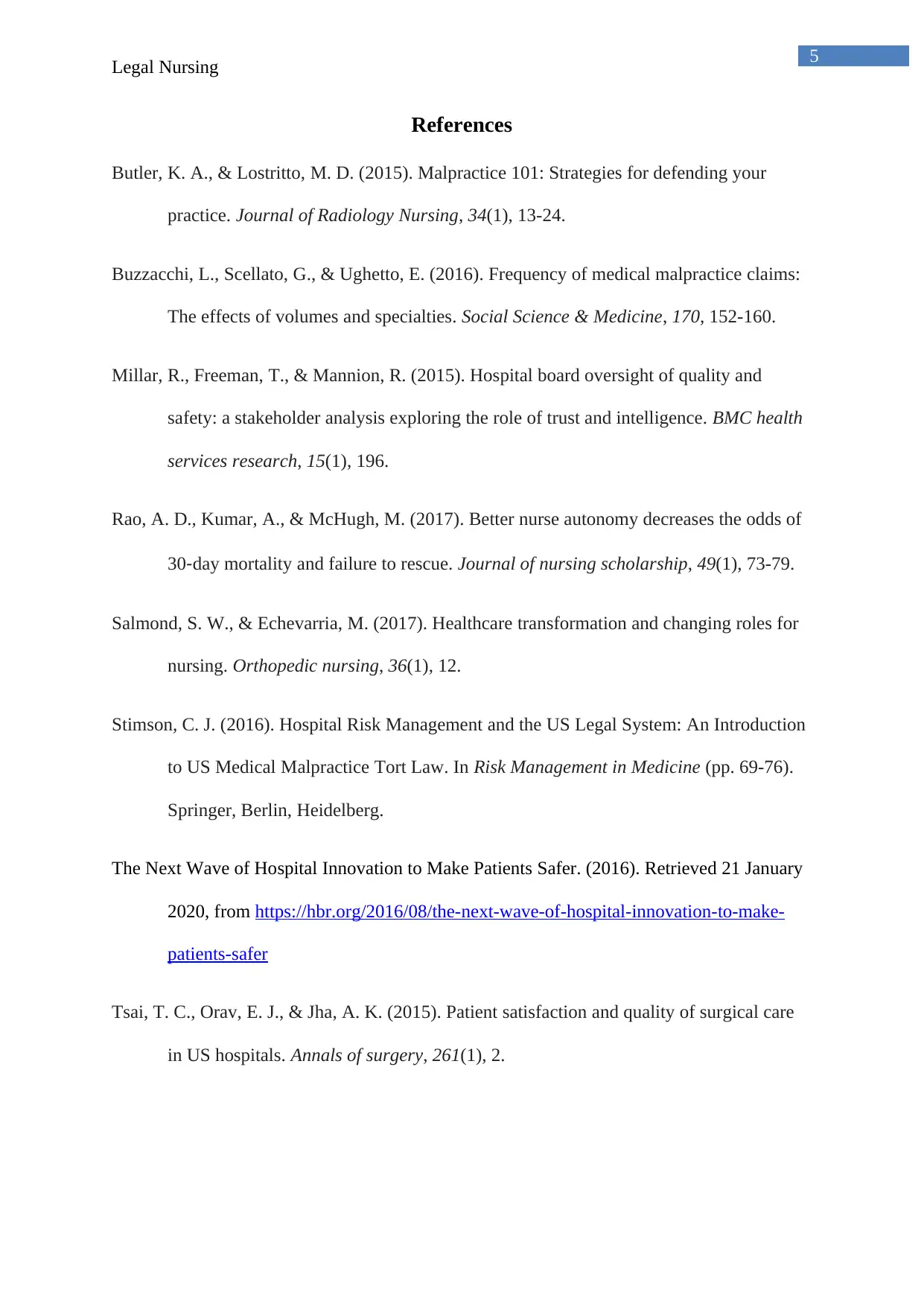
5
Legal Nursing
References
Butler, K. A., & Lostritto, M. D. (2015). Malpractice 101: Strategies for defending your
practice. Journal of Radiology Nursing, 34(1), 13-24.
Buzzacchi, L., Scellato, G., & Ughetto, E. (2016). Frequency of medical malpractice claims:
The effects of volumes and specialties. Social Science & Medicine, 170, 152-160.
Millar, R., Freeman, T., & Mannion, R. (2015). Hospital board oversight of quality and
safety: a stakeholder analysis exploring the role of trust and intelligence. BMC health
services research, 15(1), 196.
Rao, A. D., Kumar, A., & McHugh, M. (2017). Better nurse autonomy decreases the odds of
30‐day mortality and failure to rescue. Journal of nursing scholarship, 49(1), 73-79.
Salmond, S. W., & Echevarria, M. (2017). Healthcare transformation and changing roles for
nursing. Orthopedic nursing, 36(1), 12.
Stimson, C. J. (2016). Hospital Risk Management and the US Legal System: An Introduction
to US Medical Malpractice Tort Law. In Risk Management in Medicine (pp. 69-76).
Springer, Berlin, Heidelberg.
The Next Wave of Hospital Innovation to Make Patients Safer. (2016). Retrieved 21 January
2020, from https://hbr.org/2016/08/the-next-wave-of-hospital-innovation-to-make-
patients-safer
Tsai, T. C., Orav, E. J., & Jha, A. K. (2015). Patient satisfaction and quality of surgical care
in US hospitals. Annals of surgery, 261(1), 2.
Legal Nursing
References
Butler, K. A., & Lostritto, M. D. (2015). Malpractice 101: Strategies for defending your
practice. Journal of Radiology Nursing, 34(1), 13-24.
Buzzacchi, L., Scellato, G., & Ughetto, E. (2016). Frequency of medical malpractice claims:
The effects of volumes and specialties. Social Science & Medicine, 170, 152-160.
Millar, R., Freeman, T., & Mannion, R. (2015). Hospital board oversight of quality and
safety: a stakeholder analysis exploring the role of trust and intelligence. BMC health
services research, 15(1), 196.
Rao, A. D., Kumar, A., & McHugh, M. (2017). Better nurse autonomy decreases the odds of
30‐day mortality and failure to rescue. Journal of nursing scholarship, 49(1), 73-79.
Salmond, S. W., & Echevarria, M. (2017). Healthcare transformation and changing roles for
nursing. Orthopedic nursing, 36(1), 12.
Stimson, C. J. (2016). Hospital Risk Management and the US Legal System: An Introduction
to US Medical Malpractice Tort Law. In Risk Management in Medicine (pp. 69-76).
Springer, Berlin, Heidelberg.
The Next Wave of Hospital Innovation to Make Patients Safer. (2016). Retrieved 21 January
2020, from https://hbr.org/2016/08/the-next-wave-of-hospital-innovation-to-make-
patients-safer
Tsai, T. C., Orav, E. J., & Jha, A. K. (2015). Patient satisfaction and quality of surgical care
in US hospitals. Annals of surgery, 261(1), 2.
⊘ This is a preview!⊘
Do you want full access?
Subscribe today to unlock all pages.

Trusted by 1+ million students worldwide
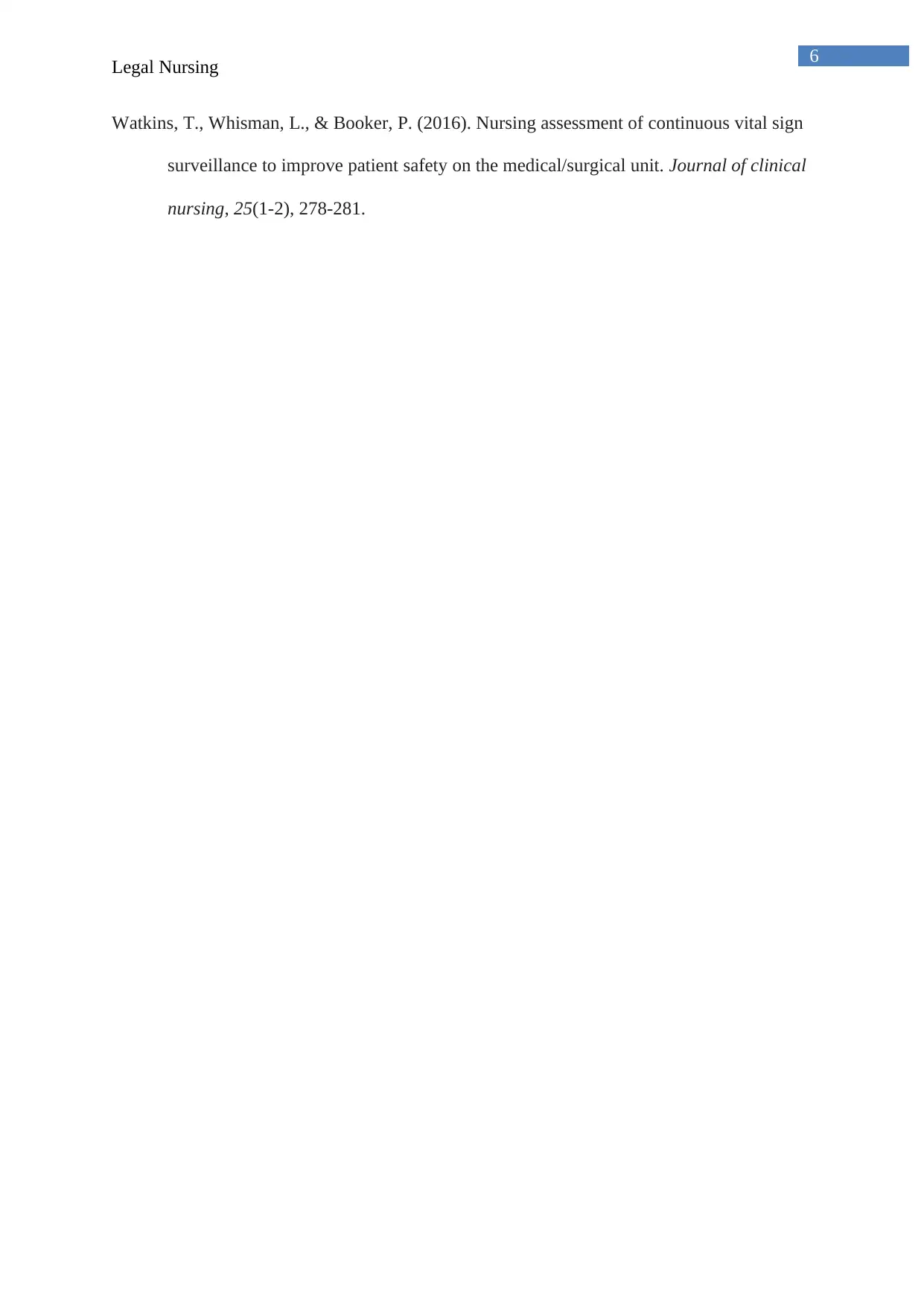
6
Legal Nursing
Watkins, T., Whisman, L., & Booker, P. (2016). Nursing assessment of continuous vital sign
surveillance to improve patient safety on the medical/surgical unit. Journal of clinical
nursing, 25(1-2), 278-281.
Legal Nursing
Watkins, T., Whisman, L., & Booker, P. (2016). Nursing assessment of continuous vital sign
surveillance to improve patient safety on the medical/surgical unit. Journal of clinical
nursing, 25(1-2), 278-281.
1 out of 7
Related Documents
Your All-in-One AI-Powered Toolkit for Academic Success.
+13062052269
info@desklib.com
Available 24*7 on WhatsApp / Email
![[object Object]](/_next/static/media/star-bottom.7253800d.svg)
Unlock your academic potential
Copyright © 2020–2025 A2Z Services. All Rights Reserved. Developed and managed by ZUCOL.




